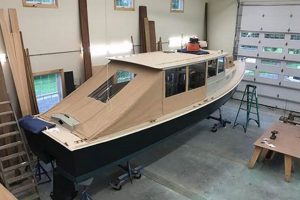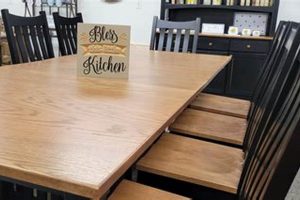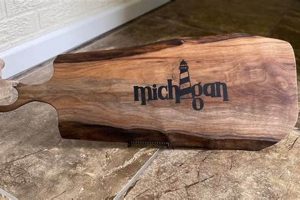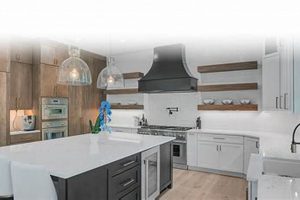The crafting of bespoke wood fixtures and installations by a specialized artisan or company represents a dedication to individualized design. These creations are typically tailored to meet the unique specifications of a client, ensuring a precise fit and aesthetic coherence within a given space. For instance, a homeowner might commission handcrafted cabinetry to maximize storage and complement the architectural style of their kitchen.
This approach offers several advantages, including unparalleled customization and enhanced aesthetic appeal. Historically, such craftsmanship has been valued for its durability and the distinct character it imparts to residential or commercial environments. The resulting pieces often become focal points, reflecting the owner’s personal taste and contributing to the overall value of the property.
The subsequent discussion will delve into the diverse applications of this specialized craft, explore the materials and techniques employed, and examine the factors influencing the selection of a provider for these unique services.
Guidance on Commissioning Bespoke Woodwork
The following points offer guidance for those considering the engagement of specialized woodworking services, ensuring clarity and satisfaction throughout the process.
Tip 1: Define Project Scope Precisely: Articulate the desired outcome with specificity. Provide detailed measurements, sketches, or architectural plans to ensure a clear understanding of requirements.
Tip 2: Source Quality Materials: Wood selection is paramount. Discuss the properties of different wood species durability, grain pattern, and suitability for the intended application with the craftsperson. Specify sustainable and responsibly sourced timber when feasible.
Tip 3: Request Detailed Quotations: Obtain comprehensive pricing that breaks down material costs, labor charges, and any associated fees (e.g., delivery, installation). Ensure the quotation includes a timeline for completion.
Tip 4: Review Design Proofs Meticulously: Before fabrication commences, thoroughly examine all design proofs and shop drawings. Confirm dimensions, joinery details, and finishing specifications to prevent errors.
Tip 5: Establish Clear Communication Channels: Maintain open and consistent communication with the woodworker throughout the project. Regular updates and prompt responses to inquiries minimize potential misunderstandings.
Tip 6: Inspect Work Progress Regularly: If possible, visit the workshop to observe the project’s progress. This allows for early detection of potential issues and ensures adherence to specifications.
Tip 7: Prepare the Installation Site: Ensure the installation area is clear, accessible, and free of obstructions. Proper preparation facilitates a smooth and efficient installation process.
These directives will facilitate a productive relationship with the woodworking professional and contribute to the successful realization of bespoke woodworking projects.
The article will now proceed to discuss how to evaluate the portfolio and credentials of potential artisans.
1. Bespoke design precision
The meticulous accuracy in bespoke design forms a foundational element within the realm of specialized woodworking. This precision is not merely aesthetic; it dictates the structural integrity, functional efficiency, and overall suitability of the finished product. The impact of inaccurate measurements or poorly conceived designs directly translates to material waste, compromised structural stability, and ultimately, customer dissatisfaction. For example, bespoke kitchen cabinetry lacking precise measurements will result in gaps, misalignment, and compromised functionality, undermining the intended purpose of the commissioned work. This necessitates an approach where every cut, joint, and surface detail aligns seamlessly with the pre-determined specifications.
Bespoke design precision is further exemplified in the creation of intricate architectural millwork. Detailed moldings, ornate carvings, and complex geometric patterns require unwavering adherence to design blueprints. The deviation from these pre-approved designs can compromise the aesthetic coherence of the piece, diminishing its intended artistic impact. Therefore, specialized woodworking professionals invariably utilize advanced measurement tools, computer-aided design (CAD) software, and meticulous craftsmanship techniques to mitigate errors and uphold design accuracy.
In summation, bespoke design precision is not merely a desirable attribute but a fundamental prerequisite for achieving excellence in specialized woodworking. Its presence dictates the success of each project, ensuring structural integrity, functional efficiency, and aesthetic satisfaction. Addressing the demand for high levels of precision in design and execution is thus essential for specialized woodworking businesses to thrive and maintain a reputation for exceptional quality.
2. Material selection criteria
Within the domain of bespoke woodworking, the criteria guiding material selection are pivotal. The choice of wood species and other components directly influences the aesthetic outcome, structural integrity, and longevity of the finished product. The selection process should integrate both artistic vision and practical considerations to yield optimal results.
- Aesthetic Harmony
The visual characteristics of the material must align with the intended design aesthetic. Grain patterns, color variations, and surface textures contribute significantly to the final appearance. For example, walnut may be chosen for its rich, dark tones in a formal dining room setting, while lighter maple could be favored in a contemporary kitchen design. The selection must harmonize with the surrounding environment and the client’s preferences.
- Structural Performance
Different wood species exhibit varying degrees of strength, hardness, and resistance to moisture. Selecting materials appropriate for the intended application is crucial for ensuring structural stability and durability. A load-bearing component, such as a table leg, would require a dense, hardwood like oak or maple. Conversely, less critical elements might utilize softer woods, provided they are appropriately treated and protected.
- Environmental Considerations
Responsible sourcing of materials is increasingly important. Selecting sustainably harvested wood promotes environmental stewardship and reduces the ecological footprint of the project. Certifications from organizations like the Forest Stewardship Council (FSC) provide assurance that the timber originates from responsibly managed forests. Furthermore, the use of reclaimed or salvaged wood can further minimize environmental impact.
- Budgetary Constraints
Material costs can vary significantly based on species, grade, and availability. Balancing aesthetic and performance requirements with budgetary limitations is an integral part of the selection process. Utilizing cost-effective alternatives, without compromising quality or structural integrity, requires careful consideration and expertise. The selection must meet the client’s aesthetic and functional requirements without exceeding the allocated budget.
These carefully considered material selection criteria are fundamental to the creation of enduring, visually compelling, and structurally sound pieces. The material choice directly translates into the lasting value and aesthetic appeal of the “glover custom woodwork” and should be given significant consideration.
3. Artisan skill level
The proficient execution of specialized woodworking projects hinges intrinsically on the artisan’s skill level. The quality, durability, and aesthetic appeal are direct reflections of the expertise and precision applied during each stage of the process.
- Mastery of Traditional Techniques
Proficiency in time-honored techniques, such as joinery, carving, and finishing, forms the bedrock of superior craftsmanship. Expertise in mortise-and-tenon joints, dovetail joints, and hand-applied finishes ensures structural integrity and refined aesthetics. An artisan’s ability to execute these techniques flawlessly translates directly into the longevity and value of the finished piece. For instance, precisely cut dovetails provide exceptional strength in drawer construction, indicating a higher level of craftsmanship compared to simpler joinery methods.
- Proficiency with Modern Tools and Technologies
While traditional techniques remain crucial, familiarity with modern tools and technologies enhances efficiency and precision. The skilled artisan understands the capabilities of CNC machines, laser cutters, and advanced finishing equipment and integrates these tools judiciously to augment, rather than replace, handcraftsmanship. Effective use of CAD software allows for accurate design visualization and reduces the likelihood of errors, contributing to a smoother production process.
- Problem-Solving and Adaptability
Each specialized woodworking project presents unique challenges, demanding innovative solutions and adaptability. The skilled artisan possesses the ability to troubleshoot unexpected issues, modify designs to accommodate unforeseen constraints, and implement creative solutions while maintaining the integrity of the original vision. For example, when encountering inconsistencies in wood grain, the artisan might adjust the cutting plan to minimize visual disruptions, demonstrating adaptability and problem-solving prowess.
- Attention to Detail
A meticulous focus on detail distinguishes exceptional woodworking from merely adequate execution. The artisan meticulously inspects every surface, joint, and finish, ensuring that each element meets the highest standards of quality. Precise alignment, seamless joinery, and flawlessly applied finishes demonstrate a commitment to excellence and enhance the overall aesthetic appeal of the piece. The trained eye identifies and rectifies even minor imperfections, ensuring a flawless end product.
In conclusion, the artisan’s skill level acts as the cornerstone of achieving exceptional “glover custom woodwork.” The synthesis of traditional mastery, technological proficiency, problem-solving acumen, and unwavering attention to detail directly dictates the final outcome, ensuring lasting value and client satisfaction.
4. Installation methodology
The success of “glover custom woodwork” hinges not only on design and fabrication but also critically on the chosen installation methodology. Improper installation can negate the quality of the materials and craftsmanship, resulting in functional deficiencies and aesthetic compromises. Precise installation techniques are vital to ensure the longevity, stability, and intended appearance of the woodwork within its designated environment. For example, custom cabinetry installed without proper leveling and anchoring can shift over time, leading to misaligned doors, drawers that stick, and eventual structural damage. The correlation is direct: appropriate installation methodology is a non-negotiable component of successful bespoke woodwork.
Furthermore, installation methodology varies depending on the nature of the woodwork and the characteristics of the installation site. A complex architectural millwork installation, such as paneling in a historic building, requires a different approach than installing a freestanding custom-built desk. Considerations include the type of wall construction, the presence of utilities, and the need for precise alignment with existing architectural elements. Employing the wrong methodology can lead to irreversible damage to both the woodwork and the surrounding structure. For instance, attempting to force a precisely fitted piece into an uneven opening can result in cracking or splitting, rendering the piece unusable.
In conclusion, the installation methodology serves as the final, crucial step in realizing the full potential of “glover custom woodwork.” Its impact is direct and significant, influencing the functionality, appearance, and lifespan of the piece. Challenges in installation, such as site irregularities or complex integration requirements, must be addressed with meticulous planning and skillful execution to ensure that the finished product meets the intended design specifications and provides lasting value. Neglecting the significance of the installation phase undermines the entire process of bespoke woodwork.
5. Durability and longevity
The intertwined concepts of durability and longevity represent fundamental tenets in the realm of specialized woodworking. The capacity of custom-crafted pieces to withstand the rigors of daily use and maintain their structural and aesthetic integrity over extended periods defines their ultimate value and justifies the investment in bespoke construction. The selection of high-quality materials, the implementation of superior joinery techniques, and the application of protective finishes directly impact the lifespan of the finished product. For example, a custom-built dining table constructed from kiln-dried hardwood, joined with mortise-and-tenon joints, and finished with a durable sealant is far more likely to endure generations of use compared to mass-produced furniture constructed from particleboard and assembled with staples.
The practical significance of durability and longevity extends beyond mere financial considerations. Heirloom-quality woodwork becomes an integral part of a family’s history, accumulating sentimental value and serving as a tangible link to the past. A well-maintained antique desk, passed down through generations, embodies not only functional utility but also a powerful connection to ancestral heritage. Furthermore, durable, long-lasting woodwork reduces the environmental impact associated with frequent replacement, aligning with principles of sustainability and responsible consumption. Selecting appropriate wood types, joinery and finishes increases longevity, reduces the carbon footprint and costs less in the long run as replacement or constant maintenance is less.
In summary, the pursuit of durability and longevity constitutes a guiding principle in the creation of exceptional “glover custom woodwork.” By prioritizing quality materials, time-tested techniques, and careful craftsmanship, such creations transcend mere functional objects, becoming enduring assets that enhance both the aesthetic and practical value of their environment. The commitment to durability not only safeguards the initial investment but also fosters a legacy of quality and craftsmanship that endures through time, as well as reducing the environmental footprint associated with the need to replace lower-quality goods on a regular basis.
Frequently Asked Questions about Commissioning Custom Woodwork
The following addresses common inquiries and clarifies prevalent misconceptions regarding the acquisition of bespoke woodworking services.
Question 1: What distinguishes custom woodwork from mass-produced furniture?
Custom woodwork is distinguished by its individualized design, material selection, and construction techniques. It is tailored to meet specific client requirements and architectural contexts, unlike mass-produced furniture, which adheres to standardized designs and materials.
Question 2: How is the cost of custom woodwork determined?
The cost is contingent upon factors, including the complexity of the design, the type and quantity of materials used, the labor involved, and any finishing requirements. Detailed quotations provide a breakdown of these expenses.
Question 3: What types of wood are best suited for custom projects?
The selection depends on the intended application and aesthetic preferences. Hardwoods, such as oak, maple, and walnut, offer durability and strength, while softwoods, such as pine and cedar, are suitable for decorative elements. The choice is guided by both structural and visual considerations.
Question 4: How long does a custom woodworking project typically take?
The timeline varies based on the project’s scope and complexity. Simple projects might be completed within weeks, while intricate installations could require several months. Clear communication and detailed project planning establish realistic deadlines.
Question 5: Is custom woodwork environmentally sustainable?
It can be, provided that materials are responsibly sourced and sustainable practices are implemented. Selecting reclaimed wood, specifying FSC-certified timber, and utilizing low-VOC finishes minimize environmental impact.
Question 6: What maintenance is required for custom woodwork?
Maintenance depends on the type of wood and the applied finish. Regular dusting and cleaning with appropriate products maintain appearance and prevent damage. Periodic refinishing may be required to protect the surface and prolong the lifespan of the piece.
Commissioning custom woodwork represents an investment in quality and craftsmanship, yielding unique pieces that enhance the value and aesthetic of any environment.
The subsequent article section will explore the future trends influencing specialized woodwork.
In Conclusion
This exploration of “glover custom woodwork” has illuminated the essential aspects of this specialized craft. From the precision required in bespoke design to the critical criteria for material selection, the indispensable skill of the artisan, the vital importance of proper installation methodologies, and the paramount concerns for durability and longevity, the defining characteristics of exemplary work have been clearly delineated. These factors collectively determine the ultimate quality and value proposition for individuals and organizations seeking tailored woodworking solutions.
The pursuit of superior craftsmanship, combined with a steadfast commitment to sustainable practices and innovative design solutions, will continue to shape the future of “glover custom woodwork.” Individuals are encouraged to approach prospective projects with a clear understanding of these guiding principles, thereby ensuring a successful collaboration with qualified professionals and the creation of lasting, aesthetically pleasing, and functionally superior pieces.







